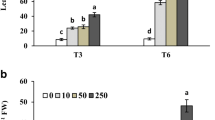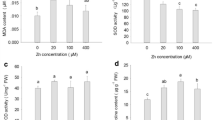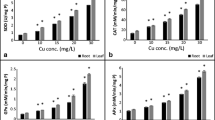Abstract
The possible role of zinc (Zn) to reverse the oxidative stress caused by mercury (Hg) was investigated in Pfaffia glomerata plantlets. Thirty-day-old acclimatized plantlets of P. glomerata were exposed to four treatments: control, 50 μM Zn, 50 μM Hg and 50 μM Zn + 50 μM Hg for 9 days. In Zn + Hg treatment, shoot and root Hg concentrations were 59 and 24% smaller than that plants exposed to 50 μM Hg added alone. An increase in the Zn concentration in the shoot of plants exposed to Zn + Hg occurred, although in the roots Zn concentration was not altered, when compared to the control. Fresh and dry weights, as well as the activity of δ-aminolevulinic acid dehydratase (δ-ALA-D) in Hg-treated plants were significantly reduced. Percentage survival, fresh and dry weights and δ-ALA-D activity of plants treated by 50 μM Zn + 50 μM Hg were greater than of that treated by Hg alone. Moreover, Zn treatment reduced the lipid peroxidation caused by Hg, being this effect related to increased root superoxide dismutase activity, and shoot catalase and ascorbate peroxidase activities. In conclusion, the presence of Zn in the substrate caused a significant reduction in the oxidative stress induced by Hg.





Similar content being viewed by others
References
Aebi H (1984) Catalase in vitro. Methods Enzymol 105:121–126
Barbosa NVB, Rocha JBT, Zeni G, Emanuelli T, Beque MMC, Braga AL (1998) Effect of organic forms of selenium on δ-aminolevulinate dehydratase from liver, kidney and brain of adult rats. Toxicol Appl Pharmacol 149:243–253
Bradford M (1976) A rapid and sensitive method for quantification of microgram quantities of protein utilizing the principle of protein-dye binding. Anal Biochem 72:248–254
Broadley MR, White PJ, Hammond JP, Zelko E, Lux A (2007) Zinc in plants. New Phytol 173:677–702
Calgaroto NS, Castro GY, Cargnelutti D, Pereira LB, Gonçalves JF, Rossato LV, Antes FG, Dressler VL, Flores EMM, Schetinger MRC, Nicoloso FT (2010) Antioxidant system activation by mercury in Pfaffia glomerata plantlets. Biometals 23:295–305
Cargnelutti D, Tabaldi LA, Spanevello RM, Jucoski GD, Battisti V, Redin M, Linares CEB, Dressler VL, Flores EMD, Nicoloso FT, Morsch VM, Schetinger MRC (2006) Mercury toxicity induces oxidative stress in growing cucumber seedlings. Chemosphere 65:999–1006
Carneiro MAC, Siqueira JO, Moreira FMS (2002) Comportamento de espécies herbáceas em misturas de solo com diferentes graus de contaminação com metais pesados. Pesq Agropec Bras 37:1629–1638
Chen L, Yang L, Wang Q (2009) In vivo phytochelatins and Hg-phytochelatin complexes in Hg-stressed Brassica chinensis L. Metallomics 1:101–106
Cho U, Park J (2000) Mercury-induced oxidative stress in tomato seedlings. Plant Sci 156:1–9
Clemens S (2006) Toxic metal accumulation, responses to exposure and mechanisms of tolerance in plants. Biochimie 88:1707–1719
Edreva A (2005) Generation and scavenging of reactive oxygen species in chloroplasts: a submolecular approach. Agricult Ecosyst Environ 106:119–133
Ellman GL (1959) Tissue sulphydryl groups. Arch Biochem Biophys 82:70–77
El-Moshaty FIB, Pike SM, Novacky AJ, Sehgal OP (1993) Lipid peroxidation and superoxide production in cowpea (Vigna unguiculata) leaves infected with tobacco ringspot virus or southern bean mosaic virus. Physiol Mol Plant Pathol 43:109–119
Emanuelli T, Rocha JBT, Pereira ME, Porciuncula LO, Morsch VM, Martins AF, Souza DOG (1996) Effect of mercury chloride intoxication and dimercaprol treatment on δ-aminolevulinate dehydratase from brain, liver and kidney of adult mice. Pharmacol Toxicol 79:138–143
Epstein E, Bloom AJ (2005) Mineral nutrition of plants: principles and perspectives. Sinauer Associates, Sunderland
Fernandez E, Gustafson A, Anderson M, Hellman B, Dencker L (2003) Cadmium-induced changes in apoptic gene expression blocked by zinc supplementation. Toxicol Sci 10:85–99
Gonçalves JF, Antes FG, Maldaner J, Pereira LB, Tabaldi LA, Rauber R, Rossato LV, Bisognin DA, Dressler VL, Flores EMM, Nicoloso FT (2009) Cadmium and mineral nutrient accumulation in potato plantlets grown under cadmium stress in two different experimental culture conditions. Plant Physiol Biochem 47:814–821
Gupta DK, Nicoloso FT, Schetinger MRC, Rossato LV, Pereira LB, Castro GY, Srivastava S, Tripathi RD (2009) Antioxidant defense mechanism in hydroponically grown Zea mays seedlings under moderate lead stress. J Hazard Mat 172:479–484
Gupta DK, Nicoloso FT, Schetinger MRC, Rossato LV, Huang HC, Srivastava S, Yang XE (2011) Lead induced responses of Pfaffia glomerata, an economically important Brazilian medicinal plant, under in vitro culture conditions. Bull Environ Contam Toxicol. doi: 10.1007/s00128-011-0226-y
Haliwell B, Gutteridge JMC (1999) Free radicals in biology and medicine. Oxford University Press, Oxford
Hart JJ, Welch RM, Norvell WA, Kochian LV (2002) Transport interactions between cadmium and zinc in roots of bread and durum wheat seedlings. Physiol Plant 116:73–78
Jacques-Silva MC, Nogueira CW, Broch LC, Flores EMM, Rocha JBT (2001) Diphenyl diselenide and ascorbic acid changes deposition of selenium and ascorbic acid in liver and brain of mice. Pharmacol Toxicol 88:119–125
Lichtenthaler HK (1987) Chlorophylls and carotenoids–pigments of photosynthetic biomembranes. Methods Enzymol 148:350–382
Loreto F, Velikova V (2001) Isoprene produced by leaves protects the photosynthetic apparatus against ozone damage, quenches ozone products, and reduces lipid peroxidation of cellular membranes. Plant Physiol 127:1781–1787
Marschner H (2002) Mineral nutrition of higher plants. Academic Press, Amsterdam
McLaughlin MJ, Palmer LT, Tiller KG, Beech TA, Smart MK (1994) Increased soil-salinity causes elevated cadmium concentrations in field-grown potato tubers. J Environ Qual 23:1013–1018
Misra HP, Fridovich I (1972) The role of superoxide anion in the autoxidation of epinephrine and simple assay for superoxide dismutase. J Biol Chem 244:6049–6055
Mittler R (2002) Oxidative stress, antioxidants and stress tolerance. Trends Plant Sci 7:405–410
Murashige T, Skoog F (1962) A revised medium for rapid growth and bioassays with tobacco tissue cultures. Physiol Plant 15:473–497
Nicoloso FT, Erig AC, Martins CF, Russowski D (2001) Micropropagação de ginseng brasileiro (Pfaffia glomerata (Spreng.) Pedersen). Braz J Med Plants 3:11–18
Noctor G, Foyer CH (1998) Ascorbate and glutathione: keeping active oxygen under control. Annu Rev Plant Physiol Plant Biol 49:249–279
Oliver DP, Wilhelm NS, McFarlane JD, Tiller KG, Cozens GD (1997) Effect of soil and foliar applications of zinc on cadmium concentration in wheat grain. Aust J Exp Agricult 37:677–681
Ortega-Villasante C, Hernández LE, Rellán-Álvarez R, Del Campo FF, Carpena-Ruiz RO (2007) Rapid alteration of cellular redox homeostasis upon exposure to cadmium and mercury in alfalfa seedlings. New Phytol 176:96–107
Patra M, Sharma A (2000) Mercury toxicity in plants. Bot Rev 66:379–422
Peixoto NC, Roza T, Flores EMM, Pereira ME (2003) Effects of zinc and cadmium on HgCl2-δ-ALA-D inhibition and Hg levels in tissues of suckling rats. Toxicol Lett 146:17–25
Pereira LB, Tabaldi LA, Gonçalves JF, Jucoski GO, Pauletto MM, Weis SN, Nicoloso FT, Borher D, Rocha JBR, Schetinger MRC (2006) Effect of aluminum on δ-aminolevulinic acid dehydratase (ALA-D) and the development of cucumber (Cucumis sativus). Environ Exp Bot 57:106–115
Reichman SM (2002) The responses of plants to metal toxicity: a review focusing on copper, manganese and zinc. Australian Mineral and Energy Environment Foundation, Melbourne
Rodríguez L, López-Bellido F, Carnicer A, Alcalde V (2003) Phytoremediation of mercury-polluted soils using crop plants. Fresenius Environ Bull 12:967–971
Santon A, Irato P, Medici V, D’Incà R, Albergoni V, Sturniolo GC (2003) Effect and possible role of Zn treatment in LEC rats, an animal model of Wilsons disease. Biochim Biophys Acta 1637:91–97
Sassa S (1982) Delta-aminolevulinic acid dehydratase assay. Enzyme 28:133–145
Skrebsky EC, Tabaldi LA, Pereira LB, Rauber R, Maldaner J, Cargnelutti D, Gonçalves JF, Castro GY, Schetinger MRC, Nicoloso FT (2008) Effect of cadmium on growth, micronutrient concentration, and δ-aminolevulinic acid dehydratase and acid phosphatase activities in plants of Pfaffia glomerata. Braz J Plant Physiol 20:285–294
Sobrino-Plata J, Ortega-Villasante C, Flores-Cáceres ML, Escobar C, Del Campo FF, Hernández LE (2009) Differential alterations of antioxidant defences as bioindicators of mercury and cadmium toxicity in alfalfa. Chemosphere 77:946–954
Taniguchi SF, Bersani-Amado CA, Sudo LS, Assef SMC, Oga S (1997) Effect of Pfaffia iresinoides on the experimental inflammatory process in rats. Phytother Res 11:568–571
Tewari RK, Kumar P, Sharma PN (2008) Morphology and physiology of zinc-stressed mulberry plants. J Plant Nutr Soil Sci 171:286–294
Tyerman SD, Bohnert HJ, Maurel C, Steudle E, Smith JAC (1999) Plant aquaporins:their molecular biology, biophysics and significance for plant water relations. J Exp Bot 50:1055–1071
Vázquez S, Carpena-Ruiz R (2005) Use of perlite in cadmium plant studies: an approach to polluted soil conditions. J Environ Monitor 7:1355–1358
Wan X, Zwiazek JJ (1999) Mercuric cloride effects on root water transport in aspen seedlings. Plant Physiol 121:939–946
Wang C, Zhang SH, Wang PF, Hou JQJ, Zhang WJ, Lu J (2009) Excess Zn alters the nutrient uptake and induces the antioxidative responses in submerged plant Hydrilla verticillata (L.f.) Royle. Chemosphere 76:938–945
Wu FB, Zhang GP (2002) Alleviation of cadmium-toxicity by application of zinc and ascorbic acid in barley. J Plant Nutr 25:2745–2761
Xylander M, Hagen C, Braune W (1996) Mercury increases light susceptibility in the green alga Haematococcus lacustris. Bot Acta 109:222–228
Zago P, Oteiza PL (2001) The antioxidant properties of zinc: interactions with iron and antioxidants. Free Radic Biol Med 31:266–274
Zang WH, Tyerman SD (1999) Inhibition of water channels by HgCl2 in intact wheat root cells. Plant Physiol 120:849–857
Zhou ZS, Wang SJ, Yang ZM (2008) Biological detection and analysis of mercury toxicity to alfalfa (Medicago sativa) plants. Chemosphere 70:1500–1509
Zhu Z et al (2004) Silicon alleviates salt stress and increases antioxidant enzymes activity in leaves of salt-stressed cucumber (Cucumis sativus L.). Plant Sci 167:527–533
Acknowledgments
The authors wish to thank the Conselho Nacional de Desenvolvimento Científico e Tecnológico (CNPq), Coordenação e Aperfeiçoamento de Pessoal de Nível Superior (CAPES) and Fundação de Amparo à Pesquisa do Estado do Rio Grande do Sul (FAPERGS) for the research fellowships.
Author information
Authors and Affiliations
Corresponding authors
Additional information
N.S. Calgaroto and D. Cargnelutti contributed equally to this work.
Rights and permissions
About this article
Cite this article
Calgaroto, N.S., Cargnelutti, D., Rossato, L.V. et al. Zinc alleviates mercury-induced oxidative stress in Pfaffia glomerata (Spreng.) Pedersen. Biometals 24, 959–971 (2011). https://doi.org/10.1007/s10534-011-9457-y
Received:
Accepted:
Published:
Issue Date:
DOI: https://doi.org/10.1007/s10534-011-9457-y




